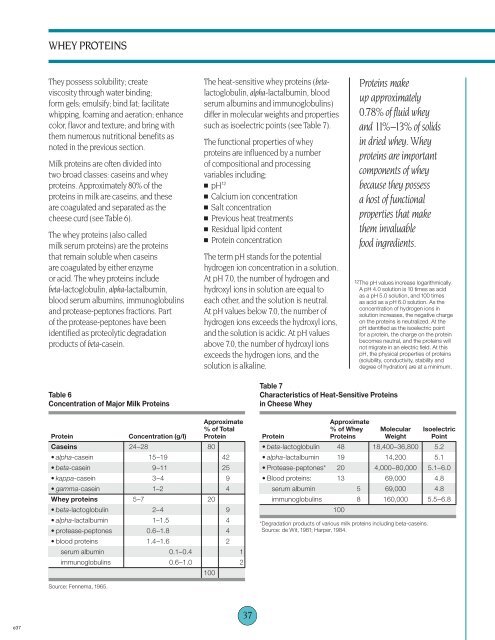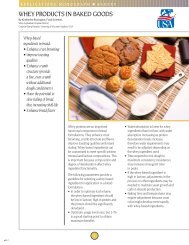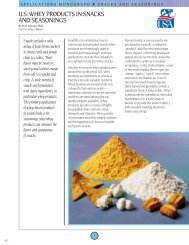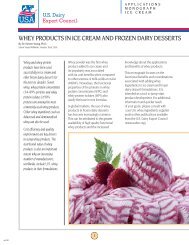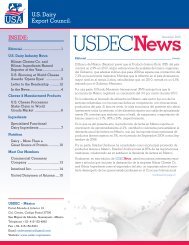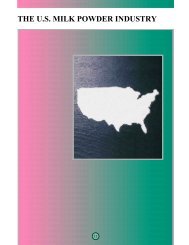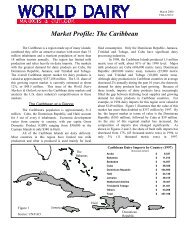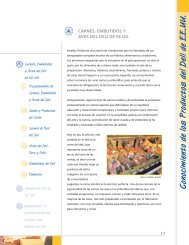nutritional and functional properties of whey and lactose
nutritional and functional properties of whey and lactose
nutritional and functional properties of whey and lactose
You also want an ePaper? Increase the reach of your titles
YUMPU automatically turns print PDFs into web optimized ePapers that Google loves.
WHEY PROTEINS<br />
They possess solubility; create<br />
viscosity through water binding;<br />
form gels; emulsify; bind fat; facilitate<br />
whipping, foaming <strong>and</strong> aeration; enhance<br />
color, flavor <strong>and</strong> texture; <strong>and</strong> bring with<br />
them numerous <strong>nutritional</strong> benefits as<br />
noted in the previous section.<br />
Milk proteins are <strong>of</strong>ten divided into<br />
two broad classes: caseins <strong>and</strong> <strong>whey</strong><br />
proteins. Approximately 80% <strong>of</strong> the<br />
proteins in milk are caseins, <strong>and</strong> these<br />
are coagulated <strong>and</strong> separated as the<br />
cheese curd (see Table 6).<br />
The <strong>whey</strong> proteins (also called<br />
milk serum proteins) are the proteins<br />
that remain soluble when caseins<br />
are coagulated by either enzyme<br />
or acid. The <strong>whey</strong> proteins include<br />
beta-lactoglobulin, alpha-lactalbumin,<br />
blood serum albumins, immunoglobulins<br />
<strong>and</strong> protease-peptones fractions. Part<br />
<strong>of</strong> the protease-peptones have been<br />
identified as proteolytic degradation<br />
products <strong>of</strong> beta-casein.<br />
The heat-sensitive <strong>whey</strong> proteins (betalactoglobulin,<br />
alpha-lactalbumin, blood<br />
serum albumins <strong>and</strong> immunoglobulins)<br />
differ in molecular weights <strong>and</strong> <strong>properties</strong><br />
such as isoelectric points (see Table 7).<br />
The <strong>functional</strong> <strong>properties</strong> <strong>of</strong> <strong>whey</strong><br />
proteins are influenced by a number<br />
<strong>of</strong> compositional <strong>and</strong> processing<br />
variables including:<br />
■ pH 12<br />
■ Calcium ion concentration<br />
■ Salt concentration<br />
■ Previous heat treatments<br />
■ Residual lipid content<br />
■ Protein concentration<br />
The term pH st<strong>and</strong>s for the potential<br />
hydrogen ion concentration in a solution.<br />
At pH 7.0, the number <strong>of</strong> hydrogen <strong>and</strong><br />
hydroxyl ions in solution are equal to<br />
each other, <strong>and</strong> the solution is neutral.<br />
At pH values below 7.0, the number <strong>of</strong><br />
hydrogen ions exceeds the hydroxyl ions,<br />
<strong>and</strong> the solution is acidic. At pH values<br />
above 7.0, the number <strong>of</strong> hydroxyl ions<br />
exceeds the hydrogen ions, <strong>and</strong> the<br />
solution is alkaline.<br />
Proteins make<br />
up approximately<br />
0.78% <strong>of</strong> fluid <strong>whey</strong><br />
<strong>and</strong> 11%–13% <strong>of</strong> solids<br />
in dried <strong>whey</strong>. Whey<br />
proteins are important<br />
components <strong>of</strong> <strong>whey</strong><br />
because they possess<br />
a host <strong>of</strong> <strong>functional</strong><br />
<strong>properties</strong> that make<br />
them invaluable<br />
food ingredients.<br />
12The pH values increase logarithmically.<br />
A pH 4.0 solution is 10 times as acid<br />
as a pH 5.0 solution, <strong>and</strong> 100 times<br />
as acid as a pH 6.0 solution. As the<br />
concentration <strong>of</strong> hydrogen ions in<br />
solution increases, the negative charge<br />
on the proteins is neutralized. At the<br />
pH identified as the isoelectric point<br />
for a protein, the charge on the protein<br />
becomes neutral, <strong>and</strong> the proteins will<br />
not migrate in an electric field. At this<br />
pH, the physical <strong>properties</strong> <strong>of</strong> proteins<br />
(solubility, conductivity, stability <strong>and</strong><br />
degree <strong>of</strong> hydration) are at a minimum.<br />
Table 6<br />
Concentration <strong>of</strong> Major Milk Proteins<br />
Approximate<br />
% <strong>of</strong> Total<br />
Protein Concentration (g/l) Protein<br />
Caseins 24–28 80<br />
• alpha-casein 15–19 42<br />
• beta-casein 9–11 25<br />
• kappa-casein 3–4 9<br />
• gamma-casein 1–2 4<br />
Whey proteins 5–7 20<br />
• beta-lactoglobulin 2–4 9<br />
• alpha-lactalbumin 1–1.5 4<br />
• protease-peptones 0.6–1.8 4<br />
• blood proteins 1.4–1.6 2<br />
serum albumin 0.1–0.4 1<br />
immunoglobulins 0.6–1.0 2<br />
100<br />
Table 7<br />
Characteristics <strong>of</strong> Heat-Sensitive Proteins<br />
in Cheese Whey<br />
Approximate<br />
% <strong>of</strong> Whey Molecular Isoelectric<br />
Protein Proteins Weight Point<br />
• beta-lactoglobulin 48 18,400–36,800 5.2<br />
• alpha-lactalbumin 19 14,200 5.1<br />
• Protease-peptones* 20 4,000–80,000 5.1–6.0<br />
• Blood proteins: 13 69,000 4.8<br />
serum albumin 5 69,000 4.8<br />
immunoglobulins 8 160,000 5.5–6.8<br />
100<br />
*Degradation products <strong>of</strong> various milk proteins including beta-caseins.<br />
Source: de Wit, 1981; Harper, 1984.<br />
Source: Fennema, 1965.<br />
e37<br />
37


